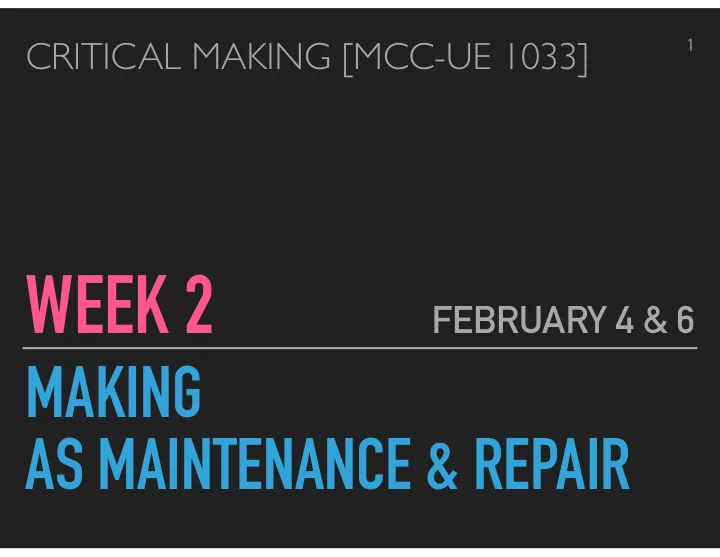

CRITICAL MAKING [MCC-UE 1033] � 1 WEEK 2 FEBRUARY 4 & 6 MAKING AS MAINTENANCE & REPAIR
� 2 “Why I Am Not a Maker” Debbie Chachra The Atlantic , January 23, 2015
� 3 OBJECTS OVER PEOPLE? “the shift … from the corporate to the individual (supported, mind, by a different set of companies selling a different set of things) … mostly re-inscribes familiar values, in slightly different form: that artifacts are important, and people are not.” (Chachra)
� 4 OBJECTS OVER PEOPLE? Baumol’s cost disease, from economics: “Suggests that it is somehow pathological that the time [cost] and energy taken by a string quartet to prepare for a performance … has not fallen in the same way as goods.”
� 5 OBJECTS OVER PEOPLE? Chachra: The “maker” designation is “mistaking what I do (teaching) for what I’m actually trying to help elicit (learning).”
� 6 SO ... WHY CRITICAL MAKING? Can we repair making? … or practice a making that properly accounts for care and maintenance?
� 7 “Hail the maintainers” Andrew Russell & Lee Vinsel aeon , April 7, 2016
� 8 INNOVATION … but what about happens after.
� 9 INNOVATION “the central fact of our industrial civilisation is labour , and most of this work falls far outside the realm of innovation”
� 10 INNOVATION What is the image of the user? “In some cases, the image of the ‘user’ could be an individual like you, sitting at your computer, but in other cases, end users are institutions – companies, governments, or universities that struggle to make technologies work in ways that their inventors and makers never envisioned.”
� 11 INNOVATION “Innovation-speak worships at the altar of change, but it rarely asks who benefits, to what end? A focus on maintenance provides opportunities to ask questions about what we really want out of technologies. What do we really care about? What kind of society do we want to live in?”
� 12 “Maintenance and Care” Shannon Mattern Places journal, November 2018
� 13 FOUR SCALES § Rust: Urban repair § Dust: Spaces of labor and care § Cracks: Fixing Objects § Corruption: Cleaning Code and Data
� 14 § RUST: URBAN REPAIR
� 15 § DUST: SPACES OF LABOR & CARE
� 16 REPRODUCTIVE LABOR social reproduction "Critics and activists have validated a greater range of (re)productive activities, to include all the mental, manual, and emotional work necessary to ‘maintain existing life and to reproduce the next generation’.” (Mattern) “things lying around the house”
� 17
� 18
� 19 CARE “How can we position ‘care’ as an integral value within the city’s architectures and infrastructures of criminal justice, designing systems and spaces for restoration rather than retribution?” (Mattern)
� 20 § CRACKS: FIXING OBJECTS Ruth Schwartz Cowan: “household labor is increasingly ‘performed with tools that can be neither manufactured nor understood by the workers who use them’.” (Mattern) planned obsolescence
� 21
� 22
� 23 SOCIAL INFRASTRUCTURE Lisa Parks on Macha, Zambia: “In open-air shops … people gather around, watch, and chat. The shop is a space of public pedagogy … the repairman opens gadgets, demonstrates technical skills, encourages observers to mend rather than discard.” (Mattern) “the context for a temporary public”
� 24 IDEALIZATION OF REPAIR “romanticization of strategies of survival” Ginger Nolan: “The ‘protean capabilities’ of the ‘Third-World bricoleur,’ Ginger Nolan argues, can be used to “enable and justify the perpetuation of economic instability.” (Mattern)
� 25 § CORRUPTION: CLEANING CODE AND DATA
� 26 SOFTWARE MAINTENANCE Nathan Ensmenger: “from the early 1960s to the present, software maintenance costs have represented between 50 and 70 percent of all total expenditures on software development.” (Mattern) Fidler & Russell: “ARPANET lived beyond its original ‘ demo ’ function thanks to the maintenance work performed by ‘sponsors, liaisons and bureaucrats who labored to sustain and link … organizations and technologies’.” (Mattern)
� 27 SOFTWARE MAINTENANCE software developers? yes, but … systems administrators content moderators
� 28 INNOVATIVE REPAIR? Jes Ellacott: emphasizes “the innovative potential of repair — highlighting the fact that cutting-edge technologies can improve maintenance [and] could ‘change how we see, value, and reward’ our maintainers.” (Mattern)
� 29 REPAIRED MAKING the “maintenance of an entire ecology” (Mattern) Making of ecology? Making within an ecology
� 30 “There will be dust. There is always dust.” (Jay Owens) damage, corrosion, decay, mess materials and bodies
� 31 REPAIRING MAKING “Three enduring truths: (1) Maintainers require care; (2) caregiving requires maintenance; and (3) the distinctions between these practices are shaped by race, gender, class, and other political, economic, and cultural forces.” “Who gets to organize the maintenance of infrastructure, and who then executes the work? “
Recommend
More recommend